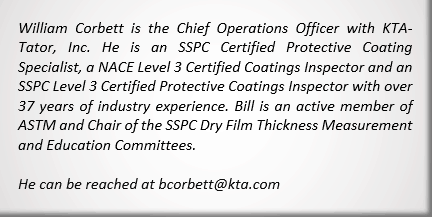One of the tasks for a specifier when selecting coating systems is to properly and thoroughly identify the prevailing service environment for existing structures/facilities, or the anticipated service environment for new structures or facilities.  Stated more simply, once the coating system is installed, what will it be subjected to, under both normal and upset operating conditions? This can be a little like gazing into a crystal ball and attempting to see into the future. Service environments can be both predictable (e.g., deicing salt exposure on a bridge in the Northeast US) and unpredictable (e.g., a 1000°F temperature spike on an exhaust stack designed to operate at 800°F).
Stated more simply, once the coating system is installed, what will it be subjected to, under both normal and upset operating conditions? This can be a little like gazing into a crystal ball and attempting to see into the future. Service environments can be both predictable (e.g., deicing salt exposure on a bridge in the Northeast US) and unpredictable (e.g., a 1000°F temperature spike on an exhaust stack designed to operate at 800°F).
When attempting to identify or predict the prevailing service environment for the purpose of coating system selection, there are several macro and micro environments to consider. Several examples are listed below. Once the service environment is identified, coating manufacturers or consulting/engineering firms can assist owners with coating system selection. Even if an engineering firm is contracted for this work, coating manufacturers must also be involved in this process, as they will need to confirm the suitability of the recommendations relative to their product lines, and provide the owner proof of successful use in the same or similar environments. The list of considerations below is not intended to be exhaustive, but rather to represent some of the considerations.
- Interior verses exterior? Consider that the effect of chemical exposure on a coating may be different in an interior verses exterior environment. In addition to any degradation caused by the chemicals, exterior exposures are subject to ultraviolet radiation from the sun that can cause color fading, gloss reduction and additional erosion over time.

- Is the exposure atmospheric, immersion, or gaseous (or a combination)? If atmospheric, what are the temperatures and are airborne contaminants present? If immersion, is it constant or intermittent (i.e., splash or wet/dry cycling), or is condensation present? If gaseous, what types of gases, temperatures, and pressures will be experienced?
- If immersion, what is the medium (potable water, waste water, salt water, solvent, acids, caustics, fuels, etc.) and what is the pH of the solution? Will the medium level fluctuate or remain constant?
- What are the contents of the vapor phase of any partial immersion environment?
- What are the temperatures (normal operating temperature and potential temperature excursions during any predictable upset conditions) of all exposures?
- What is the likelihood and type of physical damage that may occur (i.e., impact damage from river debris on dam gates, or impact damage on a bridge structure)?
- What are the characteristics of the adjacent/surrounding environment (i.e., a water tank in a rural setting verses one that is adjacent to a chemical or power generating plant).
- Is the structure near a marine environment (coastal airborne sea salt water mist)?
- Does the coating need to resist the growth of biological life (i.e., zebra mussels or fouling)?
- For tank cars of vessels, what is the type and concentration of product that will be stored/transported, and will there be multiple products?
- Access for maintenance – is it convenient or challenging?
The facility owner/specifier should identify these and other potential environmental exposures. Also consider that there may be multiple service environments for a given structure, as is commonly the case with chemical plants. Interviewing operators and plant maintenance personnel may provide greater insight into the actual service environment(s) that may not be obvious. And think of additional project-specific issues unrelated to the service environment, such as restrictions on abrasive blast cleaning, or the time of year that the work must be accomplished, or limits on total project duration. All of these factors can affect the final selection and will be needed by the coating manufacturer when preparing or reviewing the coating recommendations. Finally, consider what was used on the structure or a similar structure in the past. If the coating system provided a long service life and lowered the life cycle costs associated with maintaining the structure, then serious consideration should be made to using the same system as it is a proven solution. But recognize that some coating systems that provided excellent performance in the past may no longer be commercially available due to the presence of toxic metals like lead or chromium, or restrictions on volatile organic compounds (VOCs), such as vinyl coatings.


